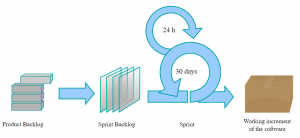SCRUM
Overview[edit]
SCRUM is a development framework that follows the agile mindset for developing and sustaining products; while it was originally aimed around software development it can be used for other development and product manufacturing processes as well, for example development of circuits or hardware, and for embedded systems that can include aspects of both hardware design and interfacing in addition to the software development aspect. As mentioned on Wikipedia, SCRUM is applicable to practices of research, sales, marketing and advanced technologies. A major point is that it is designed for teams of size ten or fewer members, and pieces of work that can be focused on during the development Sprints.
While SCRUM was initially developed for a development team, as opposed to an individual or a pair of developers, it can nevertheless still be used for a project done by an individual developer or just a pair of developers - see below entry for "Scrum for One". But also remember that SCRUM links with the Agile principles such as "Our highest priority is to satisfy the customer through early and continuous delivery of valuable software."
Learning/Recap SCRUM[edit]
In the EE department at UCT the Design Course generally gives an explanation of SCRUM, goes into some details of its operation and how to plan and organize SCRUM development.
The following sites are recommended if you are newbie to using the SCRUM methodology, or need a refresher of the practice if it's been a while since you were actively engaged in a SCRUM project.
| Site Title | URL | Comments |
|---|---|---|
| What is Scrum? Agile | https://youtu.be/oTZd2vo3FQU | For a quick recap considering watching this short video on SCRUM |
| Just Getting Started with Scrum | scruminc.com/just-getting-started-with-scrum | Short explanation of SCRUM |
| The Scrum Framework by Scrum Inc. | www.thinglink.com/scene/535528547733733377 | A visual overview of SCRUM |
One of the important aspects of SCRUM and managing what the team is doing, what they are going to do, and what they have done, is the Scrum Board. Further explanations and examples of how these look at provided at Zoho.com Scrum Board.
Scrum for One[edit]
As mentioned at the start SCRUM was originally planned for reasonably small teams around 3 - max 9 people, not really for just an individual or a pair of developers. Nevertheless, much of the principles and methods can still be used for very small teams, which often happens in BSc final year / honours projects or in postgraduate Masters or Doctoral studies. For a BSc project, Scrum is still a useful approach to use even though these projects are only a few weeks long. In such a case, for use in a short-term project like this, you may want the sprints to be only a week long; but certainly this is dependent on the amount of time the student has available in some cases, if they are doing various courses in addition to the project, it may be inefficient having such sport-duration sprints between presenting or sharing work (as one would need a sufficient amount of work to share to make a meeting useful).
There are a number of sites that provide useful practices and tips for pursuing SCRUM development using a very small team or individual work, see:
| Site Title | URL | Comments |
|---|---|---|
| Scrum Of One | https://www.raywenderlich.com/585-scrum-of-one-how-to-bring-scrum-into-your-one-person-operation | This site explains how to go about using Scrum for a one-person operation. |
| Scrum for Individuals (discussion) | https://www.infoq.com/news/2015/02/personal-scrum/ | This is more a discussion of using SCRUM for individual work. |
